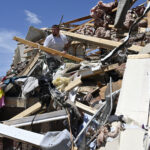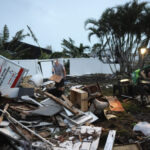The numbers loom like the mountain at the center of this storm-ravaged park.
Nearly 18 inches of rain fell in just 36 hours last fall. The deluge left an estimated $36 million in damage, fractured miles of roads and trails and forced the closure of one of the Pacific Northwest’s crown jewels for the first time in a quarter-century.
Work crews have spent thousands of hours in the months since trying to repair the damage. Now, as they prepare to reopen Mount Rainier on May 5, officials at one of the nation’s most popular national parks are looking ahead to what could be a long summer for both the mountain’s admirers and its laborers.
“We have some obstacles to overcome,” said Dave Uberuaga, who has been at Mount Rainier for 23 years, first as chief of administration and now as the park’s superintendent.
“Every road, every campground, every trail throughout the park was damaged to some extent,” he said. “Facilities that had not been damaged in the whole history were wiped out.”
The storm in early November broke records for precipitation, with 17.9 inches in 36 hours. The 41.3 inches that fell that month easily broke a park record for monthly rainfall, 32.4 inches in November 1990.
Up and down the Cascade Range, the storm submerged homes, businesses and roads. Floodwaters swept away buildings and utility lines, and two people died when they drove their vehicles into the water.
At Mount Rainier, which draws 1.5 million visitors annually, the damage was extensive. The Nisqually River overran its banks, tearing away a flood dike, the Sunshine Point Campground and a quarter-mile stretch of the west entrance road in one spot alone. On Highway 123, the north-south highway on the park’s eastern edge, landslides left 80-foot canyons where the highway once stood.
East of Paradise, a stopping point with a visitor center and inn at the foot of the mountain, washouts closed the Stevens Canyon Road in three places.
The floodwaters and debris wiped out dikes, bridges, campgrounds and trails parkwide, and in the high country, high winds tore roofs off lookouts and ripped down trees.
Local businesses struggled to stay open, relying on construction workers and area residents to get through the downturn. The Highlander Restaurant in Ashford offered incentives to lure them through the doors: Taco Tuesday and a free pool night each week.
“We had to cinch up our belt and cut our hours, cut our ice cream. You know, the little things,” waitress Jules Hayden said, while clearing dishes from a counter.
Hayden, 54, already holds down two jobs to get by, but said local business owners are optimistic.
“Let’s have a good summer,” she said. “So, it’ll be different. It’ll be interesting.”
Crews already have restored utilities to the park and repaired at least two heavily damaged sections of the Nisqually Road inside the west entrance.
At a third section, where Kautz Creek swept across the road, two massive culverts have been installed and the creek redirected slightly so that the road can be reopened to Paradise by May 5, Uberuaga said.
Visitor centers and services will be open at each of the corners of the park, but visitors who expect to be able to drive through and stop at each will be disappointed. The Stevens Canyon Road could remain closed or restricted to one lane all summer.
And that north-south connection with 80-foot canyons? Highway 123 will be shut down at least until fall, as engineers haul 55,000 tons of rock — an estimated 1,800 truckloads — into the park to rebuild the road.
Those traveling on foot will find surprises as well. By this time of year, the National Park Service has usually booked 60 percent of the hiking permits for the popular Wonderland Trail, a 93-mile meandering route through lowland forests to subalpine meadows.
Some segments of the trail will be impassible, Uberuaga said, and other paths have substantial damage as well. Still more scarred trails are expected to be uncovered as the snow melts.
“If you’re coming from the East Coast, and you’re thinking this is the year you want to do the trip of a lifetime, the Wonderland Trail, this is the year you might say, ‘I’ll wait until next year and see how it is,'” Uberuaga said.
The flood damage also slowed construction work at Paradise, where crews have been restoring the aging Paradise Inn, a historic landmark, and preparing to build a new visitor center.
More than 2,000 people have volunteered to help repair the damage at Mount Rainier. Uberuaga said park officials are working to manage that aid, while still recognizing the sensitivity of some areas of the park.
“We have roads that need to be fixed. We have trails that are in spotted owl, marbled murrelet territory, that are endangered species, and we need some equipment to do some of that repair,” he said. “We’re trying to balance out every one of these repairs in as environmentally sensitive a manner as we can.”
They’re also trying to ensure that the repairs last given changing climate conditions.
The November flood was definitely an unusual event when compared with past floods, Uberuaga said. But all of the park’s streams are fed by glaciers on the towering 14,410-foot volcano, and those glaciers, especially on the south side of Mount Rainier, have been receding over the years.
Heavy rains are going to flush more debris downstream, raising water levels. Historically, park streams have filled with sediment at a rate of about 10 inches a decade, but in the past decade, some storms have deposited up to 5 feet, he said.
“We’re doing surveys on the flooding, we’re looking at only protecting critical infrastructure at Longmire and at our bridges,” he said. “And then we’re going to have to see what the natural processes take.”
In the meantime, Uberuaga is eager to reopen the gates after the longest closure in park history.
During the shutdown, hundreds of people parked outside Mount Rainier’s west entrance each day to walk a half-mile into the park and see firsthand one area decimated by floodwaters.
Bill and Polly Lowe of Newbury, N.H., recently traveled to the Seattle area for vacation, visiting the Olympic Peninsula and other popular tourist spots. But they saved Mount Rainier for the last day before flying home, not knowing the extent of the damage.
“We’re missing Rainier,” Bill Lowe said as they were turned away. “We’re disappointed, but not disastrously. You have to stay flexible when you’re traveling. It means we have to come back.”
Was this article valuable?
Here are more articles you may enjoy.

 UBS Client Can’t Sue Bank Over Broker’s Alleged Affair With Wife
UBS Client Can’t Sue Bank Over Broker’s Alleged Affair With Wife  Central US Severe Weather Outbreak Caused Billions in Damages, AccuWeather Says
Central US Severe Weather Outbreak Caused Billions in Damages, AccuWeather Says  Two Chevron Workers Die of Injuries From Angola Platform Fire
Two Chevron Workers Die of Injuries From Angola Platform Fire  Here Comes Another Busy Atlantic Hurricane Season, But Will It Be as Crazy as 2024?
Here Comes Another Busy Atlantic Hurricane Season, But Will It Be as Crazy as 2024? 